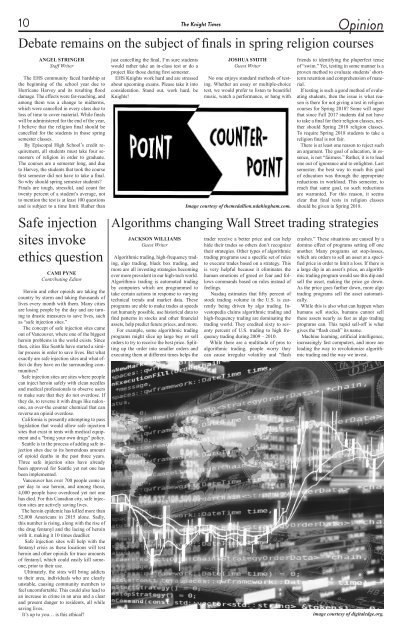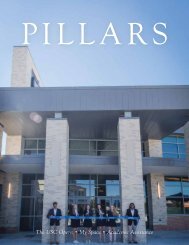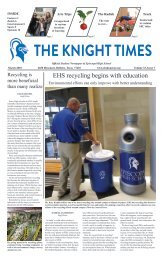THE KNIGHT TIMES - March 2018
You also want an ePaper? Increase the reach of your titles
YUMPU automatically turns print PDFs into web optimized ePapers that Google loves.
10 The Knight Times<br />
Opinion<br />
Debate remains on the subject of finals in spring religion courses<br />
ANGEL STRINGER<br />
Staff Writer<br />
The EHS community faced hardship at<br />
the beginning of the school year due to<br />
Hurricane Harvey and its resulting flood<br />
damage. The effects were far-reaching, and<br />
among them was a change to midterms,<br />
which were cancelled in every class due to<br />
loss of time to cover material. While finals<br />
will be administered for the end of the year,<br />
I believe that the religion final should be<br />
cancelled for the students in those spring<br />
semester classes.<br />
By Episcopal High School’s credit requirement,<br />
all students must take four semesters<br />
of religion in order to graduate.<br />
The courses are a semester long, and due<br />
to Harvey, the students that took the course<br />
first semester did not have to take a final.<br />
So why should spring semester students?<br />
Finals are tough, stressful, and count for<br />
twenty percent of a student’s average, not<br />
to mention the test is at least 100 questions<br />
and is subject to a time limit. Rather than<br />
Safe injection<br />
sites invoke<br />
ethics question<br />
CAMI PYNE<br />
Contributing Editor<br />
Heroin and other opioids are taking the<br />
country by storm and taking thousands of<br />
lives every month with them. Many cities<br />
are losing people by the day and are turning<br />
to drastic measures to save lives, such<br />
as “safe injection sites.”<br />
The concept of safe injection sites came<br />
out of Vancouver, where one of the biggest<br />
heroin problems in the world exists. Since<br />
then, cities like Seattle have started a similar<br />
process in order to save lives. But what<br />
exactly are safe injection sites and what effect<br />
do they have on the surrounding communities?<br />
Safe injection sites are sites where people<br />
can inject heroin safely with clean needles<br />
and medical professionals to observe users<br />
to make sure that they do not overdose. If<br />
they do, to reverse it with drugs like naloxone,<br />
an over-the counter chemical that can<br />
reverse an opioid overdose.<br />
California is presently attempting to pass<br />
legislation that would allow safe injection<br />
sites that exist in tents with medical equipment<br />
and a “bring your own drugs” policy.<br />
Seattle is in the process of adding safe injection<br />
sites due to its horrendous amount<br />
of opioid deaths in the past three years.<br />
Three safe injection sites have already<br />
been approved for Seattle yet not one has<br />
been implemented.<br />
Vancouver has over 700 people come in<br />
per day to use heroin, and among those,<br />
4,000 people have overdosed yet not one<br />
has died. For this Canadian city, safe injection<br />
sites are actively saving lives.<br />
The heroin epidemic has killed more than<br />
52,000 Americans in 2015 alone. Sadly,<br />
this number is rising, along with the rise of<br />
the drug fentanyl and the lacing of heroin<br />
with it, making it 10 times deadlier.<br />
Safe injection sites will help with the<br />
fentanyl crisis as these locations will test<br />
heroin and other opioids for trace amounts<br />
of fentanyl, which could easily kill someone,<br />
prior to their use.<br />
Ultimately, the sites will bring addicts<br />
to their area, individuals who are clearly<br />
unstable, causing community members to<br />
feel uncomfortable. This could also lead to<br />
an increase in crime in an area and a clear<br />
and present danger to residents, all while<br />
saving lives.<br />
It’s up to you… is this ethical?<br />
just cancelling the final, I’m sure students<br />
would rather take an in-class test or do a<br />
project like those during first semester.<br />
EHS Knights work hard and are stressed<br />
about upcoming exams. Please take it into<br />
consideration. Stand out, work hard, be<br />
Knights!<br />
JOSHUA SMITH<br />
Guest Writer<br />
No one enjoys standard methods of testing.<br />
Whether an essay or multiple-choice<br />
test, we would prefer to listen to beautiful<br />
music, watch a performance, or hang with<br />
friends to identifying the pluperfect tense<br />
of “swim.” Yet, testing in some manner is a<br />
proven method to evaluate students’ shortterm<br />
retention and comprehension of material.<br />
If testing is such a good method of evaluating<br />
students, then the issue is what reason<br />
is there for not giving a test in religion<br />
courses for Spring <strong>2018</strong>? Some will argue<br />
that since Fall 2017 students did not have<br />
to take a final for their religion classes, neither<br />
should Spring <strong>2018</strong> religion classes.<br />
To require Spring <strong>2018</strong> students to take a<br />
religion final is not fair.<br />
There is at least one reason to reject such<br />
an argument. The goal of education, in essence,<br />
is not “fairness.” Rather, it is to lead<br />
one out of ignorance and to enlighten. Last<br />
semester, the best way to reach this goal<br />
of education was through the appropriate<br />
reductions in workload. This semester, to<br />
reach that same goal, no such reductions<br />
are warranted. For this reason, it seems<br />
clear that final tests in religion classes<br />
should be given in Spring <strong>2018</strong>.<br />
Algorithms changing Wall Street trading strategies<br />
JACKSON WILLIAMS<br />
Guest Writer<br />
Algorithmic trading, high-frequency trading,<br />
algo trading, black box trading, and<br />
more are all investing strategies becoming<br />
ever more prevalent in our high-tech world.<br />
Algorithmic trading is automated trading<br />
by computers which are programmed to<br />
take certain actions in response to varying<br />
technical trends and market data. These<br />
programs are able to make trades at speeds<br />
not humanly possible, use historical data to<br />
find patterns in stocks and other financial<br />
assets, help predict future prices, and more.<br />
For example, some algorithmic trading<br />
programs might slice up large buy or sell<br />
orders to try to receive the best price. Splitting<br />
up the order into smaller orders and<br />
executing them at different times helps the<br />
Image courtesy of themedallion.ndahingham.com.<br />
trader receive a better price and can help<br />
hide their trades so others don’t recognize<br />
their strategies. Other types of algorithmic<br />
trading programs use a specific set of rules<br />
to execute trades based on a strategy. This<br />
is very helpful because it eliminates the<br />
human emotions of greed or fear and follows<br />
commands based on rules instead of<br />
feelings.<br />
Nasdaq estimates that fifty percent of<br />
stock trading volume in the U.S. is currently<br />
being driven by algo trading. Investopedia<br />
claims algorithmic trading and<br />
high-frequency trading are dominating the<br />
trading world. They credited sixty to seventy<br />
percent of U.S. trading to high frequency<br />
trading during 2009 – 2010.<br />
While there are a multitude of pros to<br />
algorithmic trading, people worry they<br />
can cause irregular volatility and “flash<br />
crashes.” These situations are caused by a<br />
domino effect of programs setting off one<br />
another. Many programs set stop-losses,<br />
which are orders to sell an asset at a specified<br />
price in order to limit a loss. If there is<br />
a large dip in an asset’s price, an algorithmic<br />
trading program would see this dip and<br />
sell the asset, making the price go down.<br />
As the price goes further down, more algo<br />
trading programs sell the asset automatically.<br />
While this is also what can happen when<br />
humans sell stocks, humans cannot sell<br />
these assets nearly as fast as algo trading<br />
programs can. This rapid sell-off is what<br />
gives the “flash crash” its name.<br />
Machine learning, artificial intelligence,<br />
increasingly fast computers, and more are<br />
leading the way to revolutionize algorithmic<br />
trading and the way we invest.<br />
image courtesy of digitaledge.org.

















